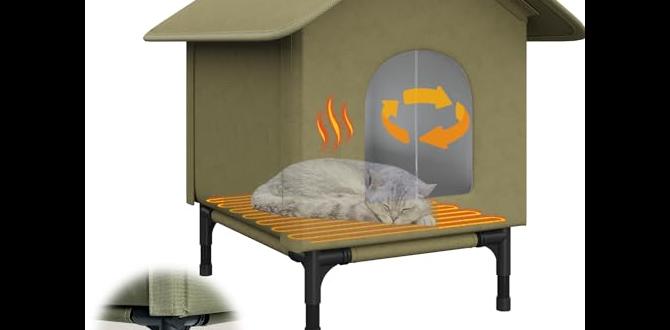Imagine your cat lounging in a cozy house outdoors, soaking up the sun. Wouldn’t that be wonderful? Building cat houses for outdoors can create a safe and comfy space for your furry friend. With the right design and materials, you can give them a perfect spot to shelter from rain or wind.
Many people think cat houses are hard to make, but that’s not true. You don’t need to be an expert builder. A few simple steps can lead to a great outdoor home for your cat. Did you know some cats love to play outside but need protection? It’s true! By making a cat house, you can help them enjoy their outdoor adventures safely.
This article shows you how to make cat houses for outdoors in easy ways. Whether you want a simple shelter or something fancy, we’ve got ideas for everyone. Let’s dive in and make your cat’s outdoor time even better!
How To Make Cat Houses For Outdoors: A Complete Guide

How to Make Cat Houses for Outdoors
Creating outdoor cat houses keeps your feline friends cozy and safe. Start with sturdy materials like wood or plastic for durability. Think about insulation to protect against harsh weather. Have you ever imagined your cat curling up in a warm, well-designed house? Add a few personal touches, like cushions or toys, to make it a favorite spot. Remember, a little creativity goes a long way!Benefits of Outdoor Cat Houses
Protects cats from harsh weather conditions. Provides a safe space to rest and play.Outdoor cat houses are fantastic for our furry friends! First, they keep cats cozy and warm during chilly days or protect them from pouring rain. Imagine a cat sipping tea while staying dry—purr-fect, right? More importantly, these little homes create a safe place for cats to nap, play, and relax. Who wouldn’t want their own castle? Think of it this way: a happy cat is a cat full of purrs, and outdoor houses are a great way to generate those sounds!
| Benefits | Description |
|---|---|
| Weather Protection | Keeps cats safe from rain and cold. |
| Safe Space | Gives cats a fun place to play and nap. |
Materials Needed for Building an Outdoor Cat House
Recommended types of wood and insulation. Tools required for construction.Creating an outdoor cat house is fun and rewarding! To start, you’ll need some specific materials. Pine or cedar wood are great choices. They resist weather and pests. Also, use foam insulation to keep your cat warm in winter. For tools, you’ll require:
- Hammer
- Saw
- Drill
- Nails or screws
- Measuring tape
Gathering these items will set you on the path to building a cozy home for your furry friend!
What type of wood should I use for a cat house?
For an outdoor cat house, use cedar or pine wood. These woods are durable and resist rot, making them ideal for outdoor use.
Types of Outdoor Cat Houses
Basic designs: DIY vs. readymade options. Features to consider: Size, shape, and accessibility.There are different types of outdoor cat houses to choose from. You can go for DIY designs or buy readymade options. Both have good and bad points. A DIY house can be fun to build. It allows for personal touches. Readymade houses save time and are usually sturdy. When picking one, think about:
- Size: Make sure it fits your cat comfortably.
- Shape: Choose shapes that keep your cat cozy and safe from weather.
- Accessibility: Ensure your cat can easily get in and out.
Considering these features will help your furry friend feel at home!
What are some features of outdoor cat houses?
Some important features include size, shape, and accessibility. Size lets your cat relax. Shape keeps them safe from rain and sun. Accessibility means they can enter easily.
Step-by-Step Guide to Building a Cat House
Preparing the foundation and base. Constructing the walls and roof.Start by choosing a flat area for your cat house. Check the ground to make sure it is even. Then, lay a sturdy base using plywood. This keeps the house stable. Next, build the walls using wooden boards. Make them tall enough for your cats to sit comfortably. For the roof, use slanted boards to help rain slide off. This keeps the inside dry.
How can I ensure my cat house is safe?
Ensure your cat house is safe by using non-toxic materials and keeping sharp edges covered. Check regularly for wear and tear. Replace any damaged parts to keep your cat safe.
- Choose a flat spot for the base.
- Use plywood for a strong foundation.
- Build walls tall enough for comfort.
- Make a slanted roof for rain protection.
Insulation and Weatherproofing Techniques
Best insulation materials for temperature control. Methods for sealing against the elements.To keep your cat cozy outside, choose the right insulation. Foam board and straw work wonders. They trap heat like a warm hug! Seal gaps with weather stripping or caulk to keep rain and wind away. No one likes a soggy kitty! Add a sloped roof to help water roll off. This simple tip can save both your cat and your house from a wet surprise!
| Insulation Material | Benefits |
|---|---|
| Foam Board | Great heat retention |
| Straw | Natural and insulating |
With these tricks, your outdoor cat house will be a fortress against the elements. Keep your feline friends warm and dry, because happy cats equal happy humans!
Location and Placement for Outdoor Cat Houses
Choosing a safe and sheltered spot. Considerations for visibility and accessibility.Choose a spot for your cat house that is safe and covered. A sheltered area protects from rain and strong winds. Look for places near bushes or walls for extra safety. Good visibility helps you find your cat easily. Also, pick a spot that’s simple for your cat to reach. Cats like cozy spots, so consider a shaded area for hotter days.
- Safe from predators
- Protected from harsh weather
- Easy for cats to enter
What is the best location for an outdoor cat house?
The best location is one that is safe, cozy, and well-hidden. A quiet, sheltered area provides comfort and safety for your cat while they relax outdoors.
Enhancements and Accessories
Adding ramps, scratching posts, and bedding. Utilizing safe plants and structures around the cat house.Imagine a cat house that feels like a cozy castle! You can add ramps for kitty climbing adventures and scratching posts for those important nail care sessions. Soft bedding is a must for nappy time, too. Surround the house with safe plants like catnip or cat grass—it’s like a feline buffet! Just keep out any sneaky plants that could make your cat sick. A little creativity goes a long way in making your outdoor cat house purrfect!
| Enhancement | Benefits |
|---|---|
| Ramp | Fun climbing and exercising |
| Scratching Post | Healthy claws and less furniture scratching |
| Bedding | Comfy naps and warmth |
| Safe Plants | Wholesome munching |
Maintenance Tips for Outdoor Cat Houses
Cleaning and inspection routines. Seasonal updates and repairs needed.Keeping outdoor cat houses in tip-top shape is like treating your cat to a spa day! Clean them regularly to keep the sneaky smells away. Use warm soap and water for washing. Check for holes or cracks every month. Cats might find extra cozy spots, like a warm towel or two! Seasonal changes can mean repairs too. Strong winds might blow the house around, so think of adding some weights! Don’t forget to be playful during inspections; toss in some catnip for fun!
| Routine | Frequency |
|---|---|
| Cleaning | Every 2 weeks |
| Inspection | Monthly |
| Seasonal Repairs | At the start of each season |
Remember, a happy cat means a happy owner! And if you ever find your cat trying to redecorate their house, it’s probably not time for a makeover, but a little maintenance.
Conclusion
In conclusion, making outdoor cat houses is fun and rewarding. You can use simple materials like wood or plastic. Make sure the house is cozy and protected from the weather. Add a soft blanket for comfort. Now that you know the basics, gather your supplies, and start building! For more ideas and tips, check out online resources and let your creativity shine!FAQs
What Materials Are Best For Building A Durable Outdoor Cat House?To build a strong outdoor cat house, use wood, plywood, or plastic. These materials are sturdy and last a long time. Make sure to keep it off the ground with some bricks or wood blocks. You should also use waterproof paint to protect it from rain.
How Can I Insulate An Outdoor Cat House To Keep My Cat Warm In Winter?To insulate an outdoor cat house, you can use foam board or straw. These materials keep the cold out and warmth in. Make sure the house has no drafts by sealing any openings. You can add a warm blanket inside for extra coziness. Remember to place the house in a spot sheltered from wind and snow.
What Size Should An Outdoor Cat House Be To Accommodate Multiple Cats Comfortably?An outdoor cat house for multiple cats should be at least 3 feet by 3 feet. This gives them enough room to play and sleep together. Make sure it has enough entrances so they can come and go easily. You don’t want them to feel crowded inside! It’s best if the house is also a bit taller, so they can snuggle up and stay warm.
How Do I Ensure The Cat House Is Safe From Predators And The Elements?To keep your cat house safe, make it strong and sturdy. Use solid materials like wood or thick plastic. Make sure it has a roof to protect from rain and sun. Put it in a safe spot, away from bushes or tall grass where animals can hide. Check it regularly for any holes or weak spots where predators might get in.
What Features Should I Include In An Outdoor Cat House To Make It Inviting For My Feline Friends?To make an outdoor cat house inviting, you should include a cozy bed for your cat to rest in. Make sure it has small openings to keep it safe and warm. Use waterproof materials to protect it from rain. You can also add some shelves for climbing and playing. Finally, put some toys inside for extra fun!






